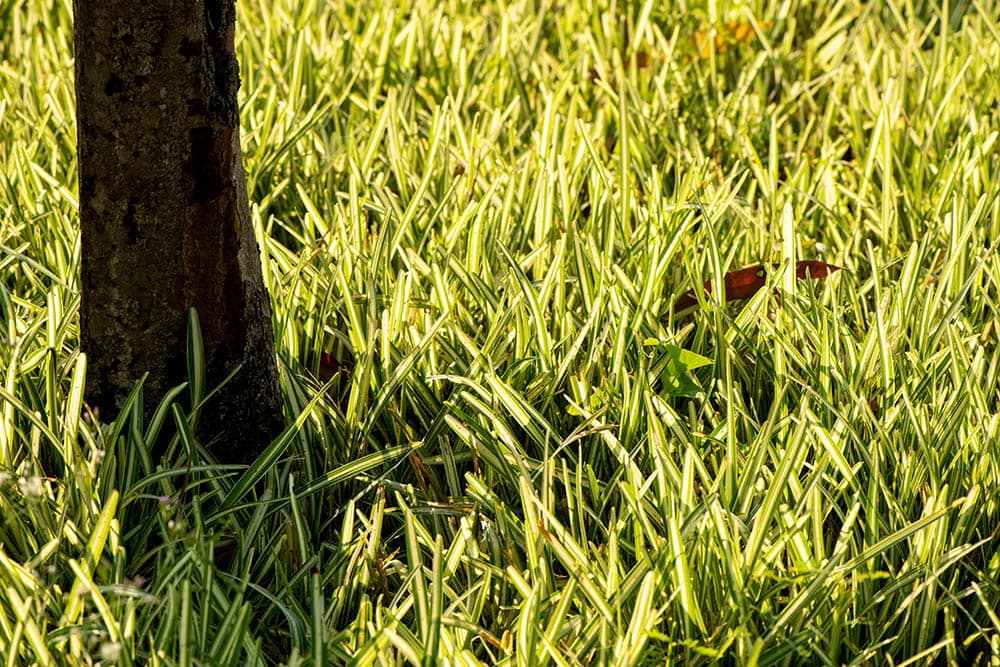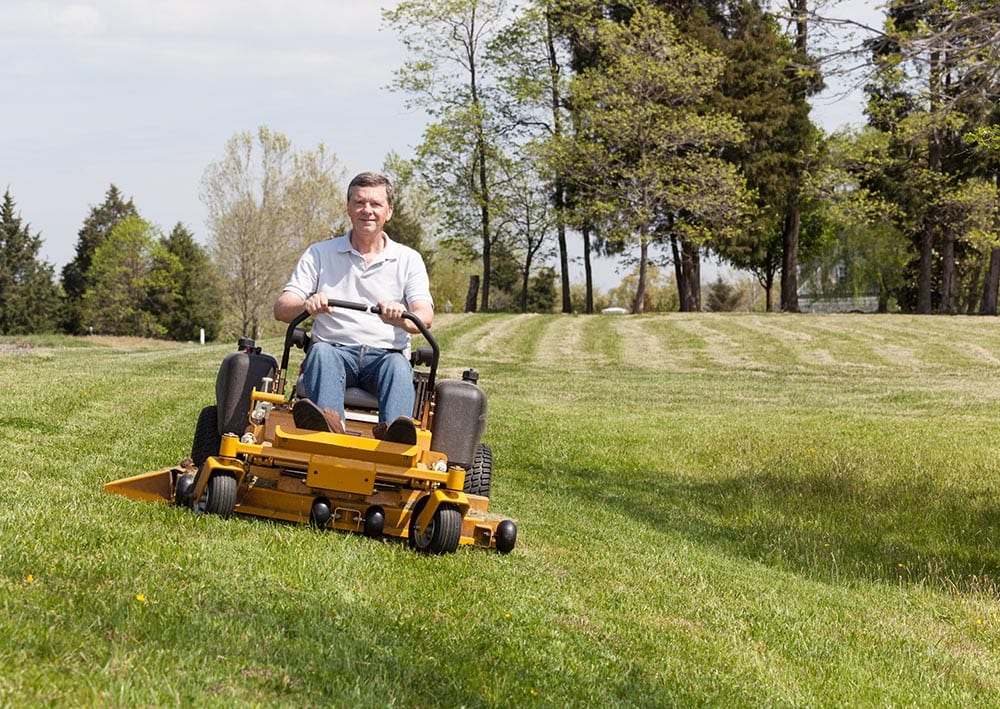9 Types of St. Augustine Grass (with Pictures)
-

- Last updated:

A good lawn must have the best turf grass that thrives even under harsh conditions. A good example of this is the St. Augustine grass, which is quite popular in residential and commercial settings.
St. Augustine grass has various cultivars and thrives in warmer climates; however, you can grow the grass in colder regions. This grass is even shade tolerant.
This article looks into the various types of St. Augustine grass and its traits.
What is St. Augustine Grass?
St. Augustine grass (Stenotaphrum secundatum) is a perennial grass that is quite dense. The blades of St. Augustine grass have a deep green shade and a coarse texture.
The grass thrives in areas with a warmer climate, but it can also grow in areas with shade. When you want to plant Sy. Augustine grass, you must consider the soil since it only does well in well-draining. It’s best suited for USDA hardiness zones 8 to 10.
You won’t have to worry about extensive skills to take good care of it. On top of that, you can still enjoy it even after winter starts since it takes time to go dormant.
Types of St. Augustine Grass (9 Types)
Before getting some St. Augustine grass, it’s important to learn about the different types you can plant. This grass has three species: Floratam, Raleigh, and Palmetto. In addition, there are 11 cultivars available that make excellent turf grass.
1. Floratam St. Augustine Grass
- Color: Dark green
- Soil pH: 5.0 to 8.5
- USDA hardiness zones: 7 to 12
- Mowing height: 3 to 4 inches
Among the native species that you can find of St. Augustine grass is Floratam. It’s available in many places thanks to its wide production. You can find it in commercial areas where lawn grass makes up part of the inventory.
Among the top traits of Floratam St. Augustine grass is that it’s easy to maintain. In addition, the grass isn’t expensive and thrives once you plant it on a lawn area. In comparison to all other St. Augustine grass types, this is by far the one with the coarsest texture.
The main purpose of producing it was to have a variety that isn’t susceptible to illness. In addition, the grass is drought-resistant and can tolerate long periods of continuous dry conditions.
Some of the diseases that Floratam St. Augustine isn’t susceptible to include SAD virus, downy mildew, certain bugs, and green-leaf spot.
2. Seville St. Augustine Grass
- Color: Bluish-green
- Soil pH: 5.0 to 8.5
- USDA hardiness zones: 8 to 10
- Mowing height: 1 to 3 inches
Residential areas require top-quality grass to create the perfect landscape. Seville St. Augustine fits the bill, given its great reputation as one of the dwarf cultivars.
There are many reasons why this type of grass does so well in homes. It’s easy to grow in any soil type. It does well in acidic to alkaline soil and everything in between. In addition, the grass can grow under a shade and maintain its deep green color even when it gets cold before going dormant.
Seville St. Augustine is a drought-tolerant grass species that keeps growing even with minimal watering. Plus, it’s a low-maintenance variety, which is important when you want to be cost-efficient.
3. Mercedes St. Augustine Grass
- Color: Bluish-green
- Soil pH: 5.0 to 7.0
- USDA hardiness zones: 8 to 10
- Mowing height: 3 to 4 inches
In the 1980s, a research team at the University of Florida produced this cultivar of the St. Augustine grass.
The reason Mercedes St. Augustine is well known is due to its shade tolerating tendencies. It’s also good to grow in an area that gets frequent droughts. You can grow it and not lose the lovely appearance even in an area with moderate foot traffic.
In terms of wear, Mercedes St. Augustine has a high wear tolerance capacity. Even if there’s damage, it won’t take long to recuperate. It’s ideal for commercial and residential areas since it retains its color even when it’s cold outside. But it’s worth noting that the grass is prone to attacks by chin bugs.
4. Bitter-Blue St. Augustine Grass
- Color: Darker bluish-green
- Soil pH: 5.0 to 8.5
- USDA hardiness zones: 8 to 10
- Mowing height: 2.5 inches
St. Augustine grass has undergone extensive improvement over the years. Some of the initial results of these improvements include the Bitter-Blue St. Augustine Grass. This grass has a deeper blue-green color, grows dense, and finer to the touch.
You can plant it in a commercial or residential area with moderate foot traffic. It’s a salt-tolerant variety that makes a great lawn cover. With minimal maintenance, you can have a healthy and quite attractive appearance.
But keep an eye out for chin bugs that love attacking the grass. Also, it’s prone to green-leafy spots so have some disease and pest control measures in place when you plant it.
5. Raleigh St. Augustine Grass
- Color: Medium green
- Soil pH: 5.0 to 8.5
- USDA hardiness zones: 8 to 10
- Mowing height: 2 to 3 inches
In 1980, this cultivar of St. Augustine grass was developed in Raleigh, North Carolina. It’s quite popular in similar cold regions since it’s a cold hardy type of grass. It can tolerate temperatures of up to 10 degrees. It always retains its pale green color and isn’t quick to go dormant.
Raleigh St. Augustine is drought and disease tolerant. It has a coarse texture and thrives in areas with heavy clay soil. The soil has to be medium to low pH. It grows well even under shade but does not do well in very high temperatures.
It’s among the few St. Augustine that are yellow when there’s high temperature. This is despite the fact that it also needs full sun exposure to keep growing.
6. Sapphire St. Augustine Grass
- Color: Bluish-green
- Soil pH: 5.0 to 7.0
- USDA hardiness zones: 8 to 10
- Mowing height: 3 to 4 inches
Good grass has a fast recuperation rate and can repair wear faster to fill up blank spots. This is the exact thing that Sapphire St. Augustine is well-known for. It has a fast-lateral growth rate that works wonders when you have issues with foot traffic.
Among all the St. Augustine grass, Sapphire has the best combination of bluish-green that creates amazing lawns. The grass grows well under subtropical conditions and can withstand extended periods of drought.
It’s crucial to resod a lawn with this grass because it’s prone to brown fungus. This type requires more maintenance than the rest.
7. Delmar St. Augustine Grass
- Color: Emerald green
- Soil pH: 5.0 to 8.5
- USDA hardiness zones: 8 to 10
- Mowing height: 2 to 2.5 inches
When seeking grass with a medium coarse texture for a lawn, Delmar St. Augustine checks all the boxes. You’ll be hard pressed to find another type of grass with an amazing emerald green color. While it’s a lovely type, it’s not the most shade or drought-tolerant of St. Augustine grass.
In winter, the grass grows golden brown as it enters its dormancy stage. Still, it’s among the best St. Augustine grass that’s ideal for colder climates. There’s minimal maintenance necessary to keep it looking fresh during the growing season.
Once the grass establishes roots, it’s fairly disease-resistant. Still, it’s a great choice for residential and commercial areas looking for natural greenery.
8. Evergreen St. Augustine Grass
- Color: Bluish-green
- Soil pH: 5.0 to 7.0
- USDA hardiness zones: 8 to 10
- Mowing height: 2 to 2.5 inches
If you have an area that has lots of shade, consider planting the Evergreen St. Augustine grass. It’s the most shade tolerant type of grass with an evergreen blue-green color. The leaves are shorter and narrower.
While it is a shade-tolerant type, you can still grow it under full sun exposure. Evergreen St. Augustine retains its color even when it’s too sunny. It also restores its green color faster after winter compared to the other types of St. Augustine.
The narrow leaves of the grass are easy to maintain. However, this is only suitable for residential and commercial places with little to no foot traffic.
9. Palmetto St. Augustine
- Color: Emerald green
- Soil pH: 5.0 to 8.5
- USDA hardiness zones: 8 to 10
- Mowing height: 2 to 2.5 inches
Palmetto St. Augustine has a more solid green color and a fine texture. This is a dwarf type of grass that’s prone to developing extensive thatch.
It’s a famous type of St. Augustine since it is more shade tolerant. The grass is also drought, salt and frost-tolerant.
You can plant it in soil with varying pH and enjoy an even appearance in your lawn. This is the best St. Augustine grass for commercial and residential areas with high foot traffic.
What are the Benefits of St. Augustine Grass?
As turf grass, St. Augustine grass is a favorite of many people who want a green area around their homes. There are many benefits that come with it as seen below:
1. It’s a Hardy Grass
Some types of grass can only tolerate specific climates. If you take them anywhere else, they won’t thrive. However, St. Augustine grass does love warmer climates, but it also grows well in cold regions. This means you can even grow it under a shade and have the same deep greenish-blue hues.

2. Ideal for High Foot Traffic Areas
In commercial and residential areas, it can be challenging to find grass that suits high foot traffic areas. Some St. Augustine cultivars suit such areas and have a better recuperation rate. The grass grows faster, which means the wear won’t last long.
3. Shade Tolerance
Having areas with lots of shade, like under trees or at the side of a tall building, can be tricky to grow grass. St. Augustine is among the few species whose cultivars can tolerate growing under a shade. The grass retains its bluish-green color.
4. Drought and Disease-Resistant
St. Augustine grass cultivars have been developed to be drought and disease-resistant. Most grow well in warmer climates and can retain color even with minimal watering. The low-maintenance grass is disease and bug-resistant, but it’s good to always have control measures in place.
Conclusion
St. Augustine grass is a favorite of many commercial and residential properties across the US. The grass has different types that share a greenish-blue appearance. In winter, the grass cultivars take time to go into dormancy. Some even add color faster once the season is over.
These different types of grass are drought and disease tolerant. You can grow them in varying soils with different pH and not worry about extensive maintenance needs.
Featured Image Credit: wasanajai, Shutterstock
Contents

